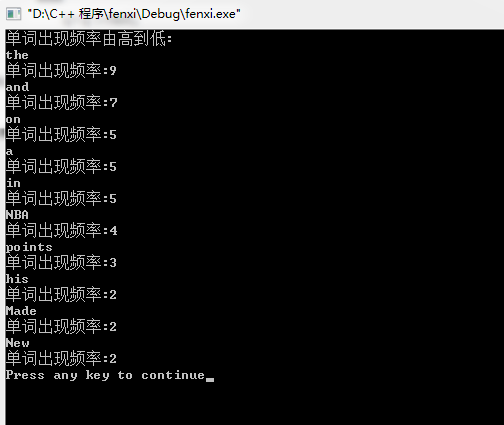分析:
(1)刚看到这个问题作为我们计算机人的第一反应应该是该用什么样的算法来实现,一使用数组,二使用链表,我觉得链表更好些,可以节约空间也不用改参数
(2)这个题的思路:先读文件,遍历分析单词频率,排序,输出
(3)语言:C语言
(4)其实刚开始我用的是数组,因为觉得链表比较麻烦,但结果用数组做的程序的质量总是不让人满意,有时要改参数,还有一些数组越界的问题,
于是我查了查网上和其他同学的做法,他们多数用的是链表,而且不会存在数组越界的问题让人豁然开朗。我有对程序进行了改进,该用链表的做法
(5)实践出真知,动手才会发现问题,然后自己分析,请教别人解决问题,在这其中也是乐趣多多哈。
(6)如有问题,请指正,下面是程序代码,运行结果。
程序代码:
#include "stdafx.h"//头文件
#include<stdio.h>
#include<stdlib.h>
#include<ctype.h>
#include<string.h>
struct fenxi {
char zifu[30];
int m;
struct fenxi *next;
};
int main() //主函数
{
struct fenxi *Head=NULL;
struct fenxi*q;
FILE *fp;
int i;
int a[10];
char b;
for(i=0;i<10;i++)
a[i]=0;
fp=fopen("d://fenxi.txt","r");//读文件
while(!feof(fp))
{
char *p=(char*)malloc(30*sizeof(char));
fscanf(fp,"%s",p);
if(Head==NULL)//分析单词频率
{
struct fenxi *temp=(struct fenxi*)malloc(sizeof(struct fenxi));
strcpy(temp->zifu,p);
temp->m=1;
temp->next=NULL;
Head=temp;
}
else
{
struct fenxi *L=Head;
while(L!=NULL)
{
if(strcmp(L->zifu,p)==0)
{
int count = L->m;
count++;
L->m = count;
break;
}
L=L->next;
}
if(L==NULL)
{
struct fenxi*temp = (struct fenxi*)malloc(sizeof(struct fenxi));
strcpy(temp->zifu, p);
temp->m=1;
temp->next=Head;
Head=temp;
}
}
}
printf("单词出现频率由高到低:\n");//排序输出
for(i=0;i<10;i++)
{
q=Head;
while(q!=NULL)
{
if(q->m>a[i])
a[i]=q->m;
else
q=q->next;
}
q=Head;
while(q!=NULL)
{
if(a[i]==q->m)
{
q->m=0;printf("%s\t\n",q->zifu);
printf("单词出现频率:%d\t\n",a[i]);
break;
}
else
q=q->next;
}
}
return 0;
}
运行结果:








 本文讨论了使用链表而非数组进行单词频率分析的程序优化过程,详细阐述了从数组转为链表的原因、具体实现步骤以及实践心得。通过实例代码展示了如何通过链表避免数组越界问题,实现高效且稳定的程序。
本文讨论了使用链表而非数组进行单词频率分析的程序优化过程,详细阐述了从数组转为链表的原因、具体实现步骤以及实践心得。通过实例代码展示了如何通过链表避免数组越界问题,实现高效且稳定的程序。
















 475
475

 被折叠的 条评论
为什么被折叠?
被折叠的 条评论
为什么被折叠?








